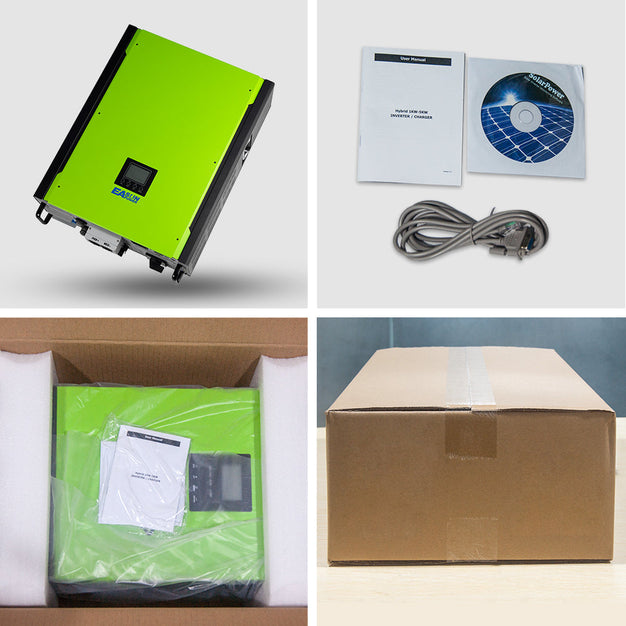Unlock the Secrets of MPPT Inverters: Transform Your Renewable Energy Game!
In today's world, the shift towards renewable energy sources has never been more crucial. As global energy demands rise and environmental concerns mount, finding efficient ways to harness energy from natural sources is imperative. This is where Maximum Power Point Tracking (MPPT) inverters come into play. These sophisticated devices play a pivotal role in optimizing energy production from renewable systems, ensuring that every ray of sunshine or gust of wind is effectively converted into usable electricity. This article aims to provide a comprehensive understanding of MPPT inverters, highlighting their significance in energy management and how they can transform your renewable energy endeavors.

Understanding MPPT Inverters
MPPT inverters are devices designed to maximize the power output from renewable energy sources, primarily solar panels. They achieve this by continuously adjusting the electrical operating point of the modules or array. The principle of Maximum Power Point Tracking lies in the understanding that solar panels have a specific point—known as the maximum power point—at which they produce the most energy. By utilizing MPPT technology, these inverters can effectively track and maintain this point, ensuring that the energy harvested is as high as possible. This is particularly crucial as environmental factors such as temperature and sunlight intensity fluctuate throughout the day. In essence, MPPT inverters serve as the brain of a renewable energy system, making real-time adjustments to maximize efficiency and output.
How MPPT Technology Works
The technology behind MPPT involves sophisticated algorithms that analyze and optimize the performance of solar panels. At its core, MPPT works by measuring the output voltage and current from the solar panels and calculating the power being produced. This data is then compared to previous readings to determine the maximum power point. If conditions change—such as cloud cover or temperature shifts—the inverter adjusts the electrical load to ensure that the system continues to operate at peak efficiency. This process of constant adjustment can present challenges, especially in rapidly changing environmental conditions. However, advancements in technology have led to more refined algorithms that improve the response time and accuracy of MPPT systems. For instance, some modern inverters can adapt to shading or varying panel orientations, allowing them to maintain optimal performance even under less-than-ideal conditions.
Benefits of Using MPPT Inverters
The advantages of MPPT inverters are manifold, making them an essential component of any renewable energy system. First and foremost, they significantly improve efficiency, often yielding 20-30% more energy compared to traditional inverter systems. This is particularly beneficial in areas with variable sunlight or wind conditions, where maximizing energy capture is critical. Additionally, MPPT technology enhances the overall performance of renewable systems, allowing them to adapt to changing environmental conditions without a decline in efficiency. Compared to traditional inverters, which may operate at fixed voltages, MPPT inverters provide a more dynamic response, ensuring that energy harvesting remains optimal under varying circumstances. This increased energy yield not only translates to lower energy costs for users but also contributes to a more sustainable energy future.
Applications of MPPT Inverters in Renewable Energy Systems
MPPT inverters are versatile and can be employed in a variety of renewable energy applications. In solar energy systems, for instance, they are essential for maximizing the output of solar panels, particularly in grid-tied applications. Additionally, MPPT technology is finding its way into wind energy systems, where it can optimize the performance of wind turbines by adjusting operational parameters based on wind speed fluctuations. Other applications include hybrid systems that combine different renewable sources, allowing for enhanced energy management and storage solutions. A friend of mine recently installed an MPPT inverter in his off-grid solar system, and he noted a remarkable increase in energy efficiency, enabling him to power his home with minimal reliance on traditional energy sources. The flexibility and efficiency provided by MPPT inverters make them a critical component in the advancement of renewable energy technologies.
Future Trends in MPPT Inverter Technology
The future of MPPT inverter technology looks promising, with ongoing innovations set to shape the landscape of renewable energy. One emerging trend is the integration of smart technologies that allow for better monitoring and control of energy systems. These advancements will enable users to optimize energy consumption dynamically and respond to grid demands in real-time. Additionally, developments in artificial intelligence and machine learning are anticipated to enhance the algorithms used in MPPT, improving tracking accuracy and overall efficiency. As the renewable energy market continues to grow, the demand for more efficient and intelligent energy management solutions will likely propel advancements in MPPT technology, making it an exciting field for both developers and users. Furthermore, as the global emphasis on sustainability and reducing carbon footprints intensifies, the role of MPPT inverters will be crucial in driving the transition to cleaner energy sources.
Maximizing Energy Efficiency with MPPT Technology
In summary, MPPT inverters are vital for maximizing the efficiency and performance of renewable energy systems. By intelligently tracking the maximum power point, these devices ensure that every bit of energy harvested is effectively utilized. As we have explored, the benefits of using MPPT technology extend beyond mere energy efficiency; they encompass various applications across solar, wind, and hybrid systems, paving the way for a sustainable energy future. As the renewable energy landscape continues to evolve, understanding and adopting MPPT inverters will be key for individuals and businesses looking to optimize their energy production. Embracing this technology can significantly enhance your renewable energy endeavors and contribute to a more sustainable world.








